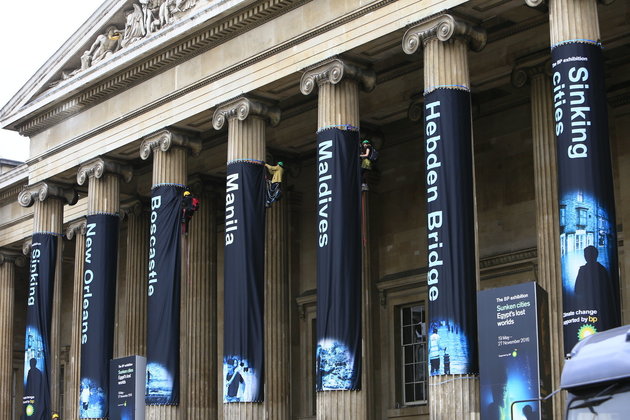
BP’s “Sunken Cities” Exhibition is “Beyond Parody”
Oh dear, BP. Last week was a lesson in how corporate sponsorship of the arts backfires badly.
Oh dear, BP. Last week was a lesson in how corporate sponsorship of the arts backfires badly.
The oil giant is used to episodes of bad publicity, such as the months of public humiliation in 2010 when the Deepwater Horizon exploded, killing eleven men and pouring millions of gallons of crude into the Gulf of Mexico.
The fallout eventually lead to the departure of its then chief executive Tony Hayward
But Big Oil never seems to learn from its mistakes. The public relations Department at BP will be full of highly paid media professionals. You may have thought that one of them would have pointed at that last week was a blatant corporate own-goal waiting to happen.
Last week, the iconic cultural institution the British Museum in London opened its “sunken cities” exhibition – its biggest event of the year. It was sponsored by BP. The exhibition showcased artefacts from two lost sunken Egyptian cities of Thonis-Heracleion and Canopus.
Surely BP must have realised that, for an oil company, which is causing climate change and sea level rise, to sponsor a “sunken cities” exhibition, it would not go unnoticed and become an object of intense ridicule and protest. The fact that much of Egypt’s coast is beginning to be seriously affected by sea level rise adds to the bitter irony of the exhibition.
It is not as if BP did not know that it would be a target for protests.
The activist group, Art Not Oil and other environmental groups have been calling for the Museum to end its sponsorship deal with BP for years. Indeed, the Museum receives less than one percent of its income from BP, but the reputational gain that BP receives is huge.
The campaign to get the Museum to drop BP is only one strand of a much greater movement to kick dirty oil out the arts, which has been gaining real traction in recent months. Two months ago, the iconic Tate stated it would end its long-term partnership with BP next year, after enduring years of protests. Not long after the Edinburgh International Festival also dumped BP too.
Earlier this month a report published by the Art Not Oil Coalition, exposed BP’s “corrupting influence” over the institutions it sponsors, revealing that it is not only buying a clean image but also buys influence over museums and politicians too.
Since then the protests have continued: Indeed, only last weekend, campaigners from Young Friends of the Earth in Northern Ireland presented an image of an oil-drenched pelican inside the Ulster Museum in Belfast, in protest at the museum’s hosting of the BP Portrait Awards.
Two days later, Art not Oil member group BP or not BP? protested at the British Museum. Indeed there were three different protests at the Museum against BP’s sponsorship in the space three few days.
BP or not BP? staged a double intervention at the British Museum against BP, including a large installation which showcased crude oil from the Gulf Coast as well as a performance with performers doused in water and singing “We do not accept BP’s vision of the future.”
BP or Not BP? also highlighted the cases of human rights violations in the country over the last 50 years when BP has been doing deals with various dictators.
“We are always concerned that the museum is allowing BP a credibility and legitimacy that it doesn’t deserve by associating itself so prominently with great art and culture,” BP or Not BP?’s Jess Worth “But this exhibition is beyond the pale … it’s beyond parody.”
Two days later on Thursday, on the official opening day, some 85 Greenpeace activists shut down the British Museum for four hours.
Fourteen of the activists scaled the Museum’s external columns in front of the entrance and hung banners of cities that are threatened by climate change, such as New Orleans, a city submerged in Hurricane Katrina, the low-lying capital of the Philippines, Manila, as well as the British town of Hebden Bridge which was submerged by floods last winter.
“Greenpeace is calling on the British Museum to end its partnership with BP,” said Greenpeace spokesman Stefano Gelmini. “The British Museum faces a choice — continue to prop up one of the world’s dirtiest companies, or drop BP and show a strong commitment to the present and future generations.”
Another Greenpeace campaigner, Elena Polisano, added: “BP sponsors the British Museum to clean up its image, burnish its reputation and secure political access. It wants to keep digging up fossil fuels well into this century. It even wants to continue drilling in the Arctic. And now it has its logo on an exhibition about cities lost to rising seas. It’s a stunning irony.”


